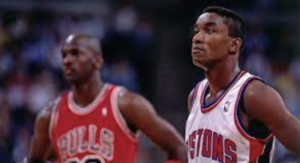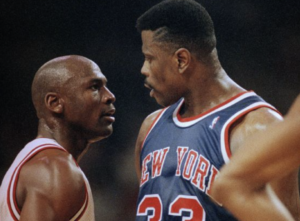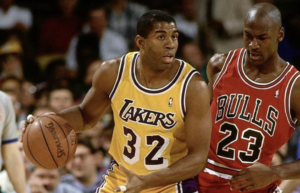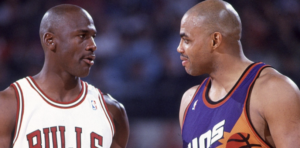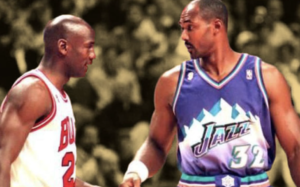Who was Jordan’s enemy?
For the majority of people, Michael Jordan is the great basketball player who has ever lived. At his peak, the distance between him and the other superstars was much more considerable than it is today. While LeBron James has lost against players like Stephen Curry, Kevin Durant, Dirk Nowitzki, and Tim Duncan in the NBA Finals and had Curry’s reign as the league’s face at least briefly threatened, Jordan was genuine without equal.
Does that imply that he was unopposed? Sometimes. He had one who, without a doubt, completely ticked him off and continues to do so today. He had others for various reasons, such as the weighted significance of intra-conference conflicts back then. Here are Michael Jordan’s top five enemies during his career.
-
Isiah Thomas
It’s been argued that an actual, demonstrable danger must exist between both parties before the term “rivalry” may be used to describe the situation. Isiah Thomas was Michael Jordan’s lone real personal foe throughout his career in that regard. In his heyday, he was unbeatable. To win back-to-back championships, Thomas’ Pistons defeated Jordan’s Bulls in the 1989 and 1990 Eastern Conference finals. Additionally, by strictly enforcing the Jordan Rules, they brutally punished His Airness. In the 10-part ESPN documentary “The Last Dance,” which follows the 1997–98 Bulls, Michael Jordan claimed that he “hated” the Pistons throughout his playing career and that this hatred “carries even to this day.”
Nobody got Jordan’s goat-like Thomas, whose Pistons memorably left the court without shaking the Bulls’ hands when Chicago overcame their difficulties and swept Detroit in the 1991 conference finals. Thomas earned Jordan’s goat, and it appears that he still does. Thomas is still upset over Jordan’s role keeping him off the 1992 Dream Team a year later, which is widely accepted and credibly reported.
The jabs are reciprocal. Thomas made it plain that Jordan doesn’t need any particular pity for having experienced a famously violent era of NBA basketball in the wake of “The Last Dance,” which depicted Jordan enduring an unusual battering during the 1980s.
According to this generation, Jordan was the only one getting hit back then, Thomas remarked. No player during that time received more hits and punishment than I did, and I have all the scars to show it, I can declare on this television station right now.
Thomas even went so far as to tell Bill Reiter of CBS Sports that Jordan was the fourth-toughest opponent he had to face throughout his career. Fourth! Kareem Abdul-Jabbar, Magic Johnson, and Larry Bird presented harder opponents for Isiah. Can you imagine how much that costs at the infamously little M.J. present time? But when a rival beat you more frequently than you beat him in head-to-head playoff matches, that is how things work out.
Although Jordan despises it, this is the case. Jordan’s lone genuine competitor during his career was and still is Thomas.
-
Patrick Ewing
Even though the “rivalry” was entirely one-sided, the 1990s Bulls and Knicks teams are inexorably intertwined, giving Ewing the No. 2 spot. During 1989, 1991, 1992, 1993, and 1996, the Bulls defeated the Knicks. When Jordan was a franchise member, New York never defeated Chicago in the postseason. In the 1993 E.C. Finals, Jordan and the Bulls handed the Knicks their most painful defeat. The Knicks jumped out to a 2-0 series lead, and it appeared that this would be the Knicks’ year to defeat Chicago and advance to the Finals. Jordan and the Bulls went on to win four straight games, including the famed “Charles Smith game,” in which Jordan and Scottie Pippen successfully stopped Smith from scoring four points at point-blank range to win Game 5 in the dying seconds.
Although Ewing was arguably the finest player for the Knicks, there was never any sense that Ewing and Jordan had a personal rivalry. Jordan and Ewing were less prominent than the Bulls and Knicks. Jordan frequently faced off against players like John Starks, and while being a Hall of Fame player, Ewing was never on par with Jordan personally.
This reminds me a little bit of LeBron James and the Heat being pushed by young Paul George and the Pacers. James was a level above George in every way. It’s difficult to say those two were competitors. However, George was Indiana’s best player, and the Pacers forced Miami to face them in two consecutive conference finals, forcing the Heat to a Game 7 in 2013. LeBron and George might have evolved into the new Jordan and Ewing had that continued for a few more seasons, with the Pacers coming close but never making it beyond the finish line.
-
Magic Johnson
Jordan’s adversary was Johnson in two ways. One, they weren’t often rivals on the court, but when they did, there was a lot at stake—the Bulls had to overcome the Lakers in the 1991 Finals to win Jordan his first championship. Johnson served as the league’s unofficial torchbearer, and two. Even though Jordan was the league’s top player by the time 1991 rolled around, Magic’s company was still very much in place to some extent. Johnson was Jordan’s competitor on and off the court in a legendary sense. Jordan discussed the necessity of winning a championship in “The Last Dance” to be compared to Larry Bird and Magic. They were successful men. Jordan was a solid individual skill but sometimes struggled to inspire his teammates. When Jordan faced Magic, who had just won consecutive league MVP honors in 1989 and 1990, he was battling all of that.
The “Showtime” Lakers were not the Lakers Jordan, and the Bulls defeated, despite persistent rumors to the contrary. Had L.A. Magic would have taken the top spot on this list if the “Showtime” Lakers had still been in existence when they faced Jordan’s Bulls, which likely would have involved more than one game. However, that Lakers team was still immensely talented.
Under 30 years old, Byron Scott and James Worthy scored 35 points per game on average that season. One of the classiest centers that are never mentioned is Vlade Divac. Magic was performing at an MVP level before his sudden retirement following the Finals due to HIV diagnosis (he averaged 19 and 12 in ’91-92).
The Lakers entered as the betting favorite, and when they won Game 1, most people believed they would win the series. But Jordan and the Bulls came roaring back to win four straight games, win the championship, and award Jordan the league’s keys in the process.
-
Charles Barkley
Barkley is the only person on this list behind Magic who has ever been regarded as the second-best player in the world. He was most likely the Dream Team’s second-best player. Without a Scottie Pippen-caliber wingman, he led the Suns to the Finals in 1993 after winning league MVP (although Kevin Johnson was, incredibly, All-NBA second or third team five out of six years from 1989-1994). In the end, Barkley and Jordan’s identities were more tightly linked than most athletes who only face each other once in their lives on a crucial stage. Part of this was due to their growing relationship and shared love of golf and gambling. However, 1993 is the only year that puts Barkley on this list. Thanks to his outstanding play during that season, he elevated himself to at least the periphery of the Jordan conversation.
And listen, in those 1993 Finals that you might recall; the Suns came far closer to pushing the Bulls to the limit or even defeating them. Despite Jordan scoring 55 points in Game 4, they were only separated by a few possessions throughout the fourth quarter. Barkley had 32 points, 12 rebounds, and ten assists but still fell short of leading the Suns to victory. If the Suns, who ultimately won Game 5, win that game, the series will be tied at two games each, making it anyone’s game. Even without it, the Suns were so close to forcing a Game 7 on their home court in Game 6 before a last-second John Paxson 3-pointer eliminated them.
-
Karl Malone
Malone is the only player on this list to have fallen to Jordan in the Finals twice, with the Jazz in striking reach. They were within one Jordan hanging follow-through jumper of forcing a Game 7 in 1998 when the series was knotted 2-2. Malone doesn’t feel competitive with Jordan. Affiliation with a conference had more significance then than it does now. The conference link made the Knicks and Pistons feel closer to Jordan, even if they never faced one other in the Finals. Before they collided with the Bulls for a few weeks in June, the Western Conference’s small-market Jazz practically lived in a different NBA universe.
Malone was still a monster. Although he was never considered the “greatest player in the world,” he did win league MVP honors in 1997 and 1999 (the latter year being the start of Jordan’s second retirement).
NBA column by mark
- Magic Johnson Success story January 24, 2024
- Michael Jordan success story January 24, 2024
- Greatest NBA Trios of All Time October 14, 2021
- Which NBA team has won the most championships? October 11, 2021
- NBA 2021/22 – Eastern Conference winner October 4, 2021
- NBA 2021/2022 DPOY Prediction? October 4, 2021
- Who is the top 10 centers of all time? October 4, 2021
- Top 10 small forwards of all time October 4, 2021
- Top 10 NBA shooting guards of all time October 4, 2021
- NBA rookie of the year 2022 September 29, 2021
